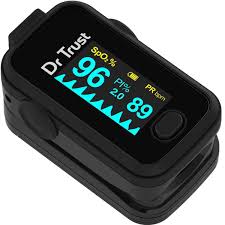A finger pulse oximeter is a medical device used to measure the oxygen saturation level (SpO2) and pulse rate of
an individual. It is a small, portable, and non-invasive device that has become especially relevant in monitoring the
health of individuals with respiratory conditions, such as chronic obstructive pulmonary disease (COPD), asthma,
or during the COVID-19 pandemic. Here’s how a finger pulse oximeter works and its key features:
Measurement Principle: The device uses a simple and painless method to measure oxygen saturation. It typically
employs two LEDs (light-emitting diodes) emitting red and infrared light through a translucent part of the body,
usually a fingertip or earlobe. A photodetector on the opposite side of the finger measures how much light is absorbed
by oxygenated and deoxygenated hemoglobin in the blood.
Oxygen Saturation (SpO2): The result of this measurement is the SpO2 level, which represents the percentage
of hemoglobin in the blood that is saturated with oxygen. A normal SpO2 level is typically between 95% and 100%.
Levels below 90% may indicate a potential oxygen deficiency in the blood.
Pulse Rate: In addition to SpO2, most finger pulse oximeters also display the individual’s pulse rate (heart rate).
This is the number of heartbeats per minute (bpm). A typical resting heart rate for adults is between 60 and 100 bpm.
Display: Finger pulse oximeters have a small digital display that shows the SpO2 level and pulse rate in real-time.
Portable and Easy to Use: They are small, lightweight, and designed for ease of use. Users simply place their
finger in the device.
Applications:
Finger pulse oximeters are used in various settings, including hospitals, clinics, emergency medical services, and at
home. They are particularly useful for monitoring patients with respiratory conditions, assessing oxygen levels
during physical activity or high-altitude travel, and for early detection of potential health issues.
Accuracy: While finger pulse oximeters are generally accurate, the accuracy can be affected by factors like poor
circulation, nail polish, or cold fingers. It’s important to follow the manufacturer’s instructions for proper use.
Limitations: Finger pulse oximeters may not be suitable for all situations, and they should not be relied upon as the
sole indicator of a person’s overall health. Clinical evaluation by a healthcare professional is necessary for a
comprehensive assessment of a person’s respiratory and cardiovascular status.
Finger pulse oximeters have become more widely available and affordable, making them a valuable tool for
monitoring oxygen levels in various healthcare scenarios, especially during the ongoing COVID-19 pandemic and
for managing chronic respiratory conditions. However, it’s crucial to use them as directed and consult a healthcare
professional if there are concerns about oxygen levels or any related health issues.


